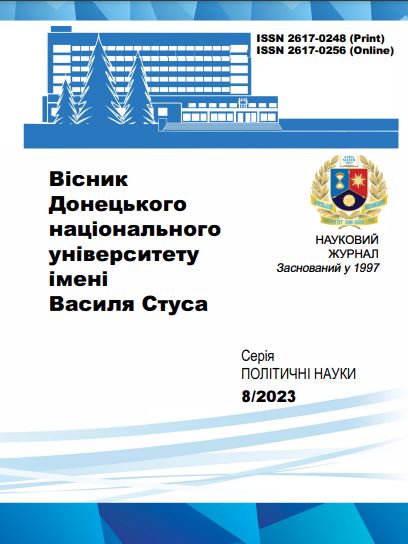Theoretical paradigms of transformation of the state as a public institution
DOI:
https://doi.org/10.31558/2617-0248.2023.8.1Keywords:
state; public policy; public administration; public actors; civil society; public administrationAbstract
The development of socio-political life in the process of policy implementation in democratic systems has become significantly more complex and has gone beyond the state. The number of actors who make decisions or influence their adoption has increased, and the mechanisms for implementing management practices that involve the coordination of interests and a culture of consensus among all actors in the public process have changed. This trend can be clearly seen in the European tradition, where public policy is not only the development and implementation of administrative decisions by the state, but also the democratic participation of various interest groups, state and non-state political actors in the political and administrative process (public deliberation), achieving a comprehensive vision of a social problem in compliance with the procedures for reconciling interests before direct political action by the government.
At the end of the twentieth century, traditional models of state governance proved insensitive to the political realities of post-industrial society, namely, the development of globalization processes and global economic competition, the emergence of supranational institutions and the development of civil society. In the 90s, the classical concept of public administration, the welfare state and the government was replaced by a new public management based on the principles of commercialization of public administration and governance that takes into account the public interest[1].
In modern conditions, the state ceases to play a monopoly role in the political process, although it remains the main actor in the public field. The impact of transformational processes in the public sphere affects the change of the state's mission, structure, functions and management technologies in modern society. Moderation, partnership, and mediation through cooperation, rather than vertical-subordinate hierarchical management and mobilization through imposition, are becoming the imperative rules of the modern state.
References
Чальцева, О.М.(2017). Публічна політика: теоретичний вимір і сучасна практика. Монографія. Вінниця. 336 с.
Governance: Concepts and Applications. (1999). Corkery, Joan (ed.), with IIAS Working Group, International Institute for Administrative Studies Brussels. 173 р.; Pollitt, C. (2004). Public Management Reform: A Comparative Analysis. C. Pollitt, G. Bouckaert. Oxford: University Press. 240 p.; Bouckaert, G. (2002). Modernizing the Rechtsstaat: Paradoxes of the Management Agenda. Berlin: Duncker & Humblot.
Hyden, G. (1992). The Study of Governance. Ed. by G. Hyden and M. Bratton. Governance and Politics in Africa. Boulder: Lynne Rienner Publishers, P. 1-26.
Huntington, S.P. (1968). Political Order in Changing Societies. New Haven. 263 p.
«GOOD GOVERNANCE» як одна із сучасних моделей державного управління. (2010). Науковий вісник Академії муніципального управління. Серія: Управління. Вип. 1. С. 112-120.
Свірін, М.Г.(2008). Механізми наближення системи публічного управління України до європейських стандартів: регіональний та субрегіональний рівень К.: НАДУ.48 с.
Клімушин, П.С., Спасібов, Д.В. (2017). Концепція сервісно орієнтованої держави в контексті модернізації публічного управління. Теорія та практика державного управління 2(57).С.1-8.
Dani, А. Anis. (2008). Inclusive States: Social Policy and Structural Inequalities. Published by: World Bank. Washington DC.

